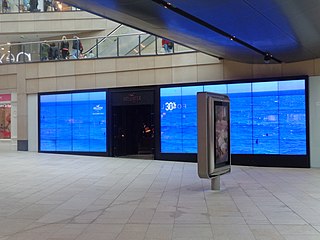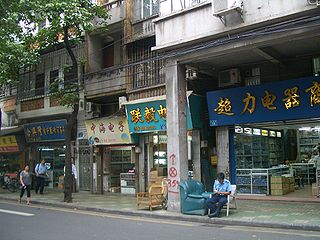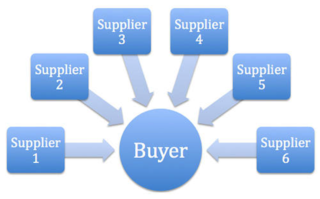
Marketing is the act of satisfying and retaining customers. It is one of the primary components of business management and commerce.

Wholesaling or distributing is the sale of goods or merchandise to retailers; to industrial, commercial, institutional or other professional business users; or to other wholesalers and related subordinated services. In general, it is the sale of goods in bulk to anyone, either a person or an organization, other than the end consumer of that merchandise. Wholesaling is buying goods in bulk quantity, usually directly from the manufacturer or source, at a discounted rate. The retailer then sells the goods to the end consumer at a higher price making a profit.

Sales are activities related to selling or the number of goods sold in a given targeted time period. The delivery of a service for a cost is also considered a sale. A period during which goods are sold for a reduced price may also be referred to as a "sale".
In sales, commerce and economics, a customer is the recipient of a good, service, product or an idea, obtained from a seller, vendor or supplier via a financial transaction or an exchange for money or some other valuable consideration.

Distribution is the process of making a product or service available for the consumer or business user who needs it, and a distributor is a business involved in the distribution stage of the value chain. Distribution can be done directly by the producer or service provider or by using indirect channels with distributors or intermediaries. Distribution is one of the four elements of the marketing mix: the other three elements being product, pricing, and promotion.
Business-to-government (B2G), also known as business-to-public-administration (B2PA) or business-to-public-sector (B2PS) refers to trade between the business sector as a supplier and a government body as a customer playing a major impact in public procurement. Business-to-government also includes the segment of business-to-business (B2B) marketing known as public sector marketing — a form of business-to-business-to-government (B2B2G) phenomenon, which encompasses marketing products and services to various government levels—local, state/provincial, and national—through integrated marketing communications techniques such as strategic public relations, branding, marketing communications, advertising, and web-based communications.
A request for proposal (RFP) is a document that solicits a proposal, often made through a bidding process, by an agency or company interested in procurement of a commodity, service, or valuable asset, to potential suppliers to submit business proposals.

Service economy can refer to one or both of two recent economic developments:

Business-to-business is a situation where one business makes a commercial transaction with another. This typically occurs when:
Complex sales, also known as Enterprise sales, can refer to a method of trading sometimes used by organizations when procuring large contracts for goods and/or services where the customer takes control of the selling process by issuing a Request for Proposal (RFP) and requiring a proposal response from previously identified or interested suppliers. Complex sales involve long sales cycles with multiple decision makers. Multiple stakeholders and stakeholder groups contribute to every complex sale. These types of sales can take up to 8 to 18 months as multiple people from higher management are involved.
A purchasing cooperative is a type of cooperative arrangement, often among businesses, to agree to aggregate demand to get lower prices from selected suppliers. Retailers' cooperatives are a form of purchasing cooperative. Cooperatives are often used by government agencies to reduce costs of procurement. Purchasing Cooperatives are used frequently by governmental entities, since they are required to follow laws requiring competitive bidding above certain thresholds. In the United States, counties, municipalities, schools, colleges and universities in the majority of states can sign interlocal agreements or cooperative contracts that allow them to legally use contracts that were procured by another governmental entity. The National Association of State Procurement Officials (NASPO) reported increasing use of cooperative purchasing practices in its 2016 survey of state procurement.
B2B e-commerce, short for business-to-business electronic commerce, is the sale of goods or services between businesses via an online sales portal. In general, it is used to improve the efficiency and effectiveness of a company's sales efforts. Instead of receiving orders using human assets manually – by telephone or e-mail – orders are received digitally, reducing overhead costs.
Business marketing is a marketing practice of individuals or organizations. It allows them to sell products or services to other companies or organizations that resell them, use them in their products or services, or use them to support their works. It is a way to promote business and improve profit too.

Once the strategic plan is in place, retail managers turn to the more managerial aspects of planning. A retail mix is devised for the purpose of coordinating day-to-day tactical decisions. The retail marketing mix typically consists of six broad decision layers including product decisions, place decisions, promotion, price, personnel and presentation. The retail mix is loosely based on the marketing mix, but has been expanded and modified in line with the unique needs of the retail context. A number of scholars have argued for an expanded marketing, mix with the inclusion of two new Ps, namely, Personnel and Presentation since these contribute to the customer's unique retail experience and are the principal basis for retail differentiation. Yet other scholars argue that the Retail Format should be included. The modified retail marketing mix that is most commonly cited in textbooks is often called the 6 Ps of retailing.
Industrial market segmentation is a scheme for categorizing industrial and business customers to guide strategic and tactical decision-making. Government agencies and industry associations use standardized segmentation schemes for statistical surveys. Most businesses create their own segmentation scheme to meet their particular needs. Industrial market segmentation is important in sales and marketing.
In marketing, a customer value proposition (CVP) consists of the sum total of benefits which a vendor promises a customer will receive in return for the customer's associated payment.
Business-to-employee (B2E) electronic commerce uses an intrabusiness network which allows companies to provide products and/or services to their employees. Typically, companies use B2E networks to automate employee-related corporate processes. B2E portals have to be compelling to the people who use them. Companies are competing for eyeballs of their employees with eBay, yahoo and thousands of other web sites. There is a huge percentage of traffic to consumer web sites comes from people who are connecting to the net at the office.

In a supply chain, a vendor, supplier, provider or a seller, is an enterprise that contributes goods or services. Generally, a supply chain vendor manufactures inventory/stock items and sells them to the next link in the chain. Today, these terms refer to a supplier of any goods or service.

A reverse auction is a type of auction in which the traditional roles of buyer and seller are reversed. Thus, there is one buyer and many potential sellers. In an ordinary auction also known as a forward auction, buyers compete to obtain goods or services by offering increasingly higher prices. In contrast, in a reverse auction, the sellers compete to obtain business from the buyer and prices will typically decrease as the sellers underbid each other.
There are many types of e-commerce models', based on market segmentation, that can be used to conducted business online. The 6 types of business models that can be used in e-commerce include: Business-to-Consumer (B2C), Consumer-to-Business (C2B), Business-to-Business (B2B), Consumer-to-Consumer (C2C), Business-to-Administration (B2A), and Consumer-to-Administration








